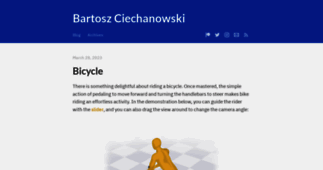Bartosz Ciechanowski
Enter a key term, phrase, name or location to get a selection of only relevant news from all RSS channels.
Enter a domain's or RSS channel's URL to read their news in a convenient way and get a complete analytics on this RSS feed.
Unfortunately Bartosz Ciechanowski has no news yet.
But you may check out related channels listed below.
[...] more powerful toys out there. This article is focused on mesh transforms. The core idea of a mesh transform is very straightforward: you introduce a set of vertices in the layer then you move them [...]
[...] of generated framebuffer. Long story short, using a new feature of OpenGL ES 3.0 called Transform Feedback, we do have an access to the output of the vertex shader. Transform Feedback Here’s [...]
[...] of CALayer’s properties are defined in points, there are a few that make use of unit coordinates, the anchorPoint being probably the most popular one. CAMeshVertex makes use of unit [...]
[...] in computer graphics, but also they’re just so much fun to play with. Dragging the control points and watching the curve wiggle is an experience on its own. The most popular Bézier [...]
[...] all of its vertices: Shape of subdivided mesh vs its vertices In fact, the vertices are control points of a surface and by observing how they influence the shape I suspect CAMeshTransform actually [...]
[...] to sneeze at, but there are much more powerful toys out there. This article is focused on mesh transforms. The core idea of a mesh transform is very straightforward: you introduce a set of vertices [...]
[...] with the exact same arguments. Fortunately, at this point we have access to the source code of Objective-C runtime which makes further investigation much easier. The class_createInstance( [...]
[...] like magic. As a companion to this article, I created a GitHub repo that contains the source code for many discussed concepts, as well as benchmarks that were run to measure the [...]
[...] ;t bother you with the equations, you can look up the exact solution directly in the source code. With the tangent vector in hand it’s just the matter of generating the correct [...]
[...] the typical GPU programming works as follow: submit some vertex geometry process it in vertex shader let the GPU figure out the triangles process each fragment in fragment shader present result [...]
[...] view hierarchy has to be rendered into a texture before its submitted to OpenGL. The textured vertex mesh then gets displayed by GLKView which is the the main workhorse of BCMeshTransformView. This [...]
[...] , while the GPU took a third of a second to do the work. Even for as little as 4096 float input values (2048 two dimensional vectors), the GPU is almost twice as fast as the CPU. How? From [...]
[...] or two segments. Instead, we should opt for slightly biased function that will boost smaller input values. We’re going to pick hyperbola – it’s just so awesome: Hyperbola For small [...]
[...] more powerful toys out there. This article is focused on mesh transforms. The core idea of a mesh transform is very straightforward: you introduce a set of vertices in the layer then you move them [...]
Related channels

